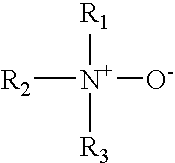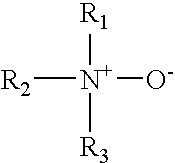Methods and aqueous acid solutions for acidizing wells containing sludging and emulsifying oil
a technology of sludge and emulsification oil, applied in the direction of fluid removal, borehole/well accessories, chemistry apparatus and processes, etc., can solve the problems of hydrochloric acid corrosion inhibitors, incompatibility, loss of acidizing performance, etc., and achieve the effect of reducing the formation of sludge and emulsions
- Summary
- Abstract
- Description
- Claims
- Application Information
AI Technical Summary
Benefits of technology
Problems solved by technology
Method used
Image
Examples
example 1
[0031] A conjugate ion pair of a cationic dimethylcocoalkylamine oxide surfactant and an anionic dodecyl sodium sulfate surfactant was prepared. An aqueous hydrochloric acid solution comprising water, 7% by weight hydrochloric acid, 0.68% stannous chloride dehydrate based reducing agent, 4% formic acid and 3000 parts per million ferric ion was also prepared. Emulsion tests were performed by shaking equal volumes of the aqueous hydrochloric acid solutions with and without the conjugate ion pair and a sludging and emulsifying oil together for 30 seconds, placing the acid oil mixture in a 200° F. water bath and thereafter monitoring the time for the two phases to break apart. Development of sludge was determined by filtering the break test fluids through a 100 mesh filter. Solids were washed with hot water, and then kerosene prior to classification of the amount of solids as none, trace, small, moderate or large. In a first series of tests, an additional surfactant was employed, i.e., ...
PUM
| Property | Measurement | Unit |
|---|---|---|
| temperatures | aaaaa | aaaaa |
| weight | aaaaa | aaaaa |
| acidic | aaaaa | aaaaa |
Abstract
Description
Claims
Application Information
 Login to view more
Login to view more - R&D Engineer
- R&D Manager
- IP Professional
- Industry Leading Data Capabilities
- Powerful AI technology
- Patent DNA Extraction
Browse by: Latest US Patents, China's latest patents, Technical Efficacy Thesaurus, Application Domain, Technology Topic.
© 2024 PatSnap. All rights reserved.Legal|Privacy policy|Modern Slavery Act Transparency Statement|Sitemap



